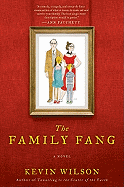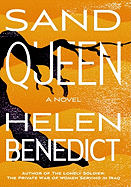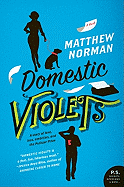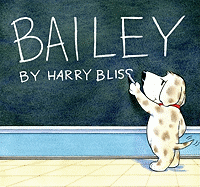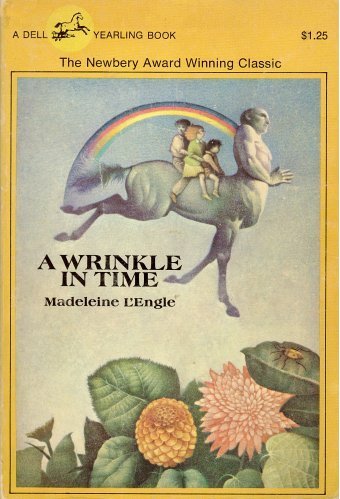 I don't remember the first book I was given, because I was still an infant when my mother started building my library--but I do remember the first book I bought on my own, with allowance money: a Dell Yearling edition of A Wrinkle in Time by Madeleine L'Engle. In fact, I still have that particular copy and have shared it with my daughters.
I don't remember the first book I was given, because I was still an infant when my mother started building my library--but I do remember the first book I bought on my own, with allowance money: a Dell Yearling edition of A Wrinkle in Time by Madeleine L'Engle. In fact, I still have that particular copy and have shared it with my daughters.
Paperback books really are extraordinary things. They share the utility of hardcover books, that perfect combination of bound content and page-turning ease that makes books such ideal tools. But paperbacks made it possible for people who couldn't afford certain titles to read them more cheaply, and they also made it possible for people to feel less troubled about losing or damaging their books. They were more portable, too: I have a few rectangular "Armed Forces Editions" of classic novels, including Of Mice and Men and The Great Gatsby, sent overseas during World War II so servicemen and -women could have reading material from home.
Paperback reading has its more frivolous side, of course. Many of us treasure holidays and vacations as a time to read more than we usually do, and toting paperback books in beach bags and suitcases makes sense. Many resorts, second homes and rental properties have shelves of left-behind paperbacks of all sizes and shapes, and it's fun to look at those collections and see the fashions of different decades on the cracked spines and dog-eared pages.
In today's issue, we pay homage to the paperback with a list of 20 of this summer's best new paperback releases. We hope you enjoy and--Happy Reading! --Bethanne Patrick
Sand Queen
by Helen Benedict
Details from the 40 interviews Helen Benedict conducted for her nonfiction book The Lonely Soldier: The Private War of Women Serving in Iraq (2009) provide the gritty verisimilitude in her new novel, Sand Queen. Along with the specifics of how female soldiers manage to change clothes in a tent full of men or make it to the shower and back unmolested, Benedict adds two memorable characters: an army reservist named Kate Brady, who has been called up halfway through her sophomore year in college to serve at Camp Bucca (based on the real-life desert prison of the same name founded in 2003 in Southern Iraq), and Naema Jassim, a medical student and refugee from Baghdad, who is trying to keep her mother and grandmother calm after her father and brother are imprisoned at Bucca.
Kate embarks upon her tour of duty at Camp Bucca buffed up and determined to blend in as a soldier, though she is one of only three women in a platoon of 39. She slings around crude military lingo, endures 14-hour shifts on a sun-blasted surveillance platform and sticks a condom over her rifle to protect it from the desert "moondust" just like the guys. The problem is that many of Kate's American comrades, and most of the Iraqi prisoners, are incapable of paying more attention to her uniform than to the body inside it. The resulting sexual harassment wears on Kate's psyche, and drives the plot of Sand Queen.
Sand Queen is replete with authentic detail and brutal incident, but the novel is not a screed as much as a sober depiction of the realities of war for both military and civilian women. If Kate's narrative feels more complete, Naema's chapters provide a balancing perspective from the other side of the razor wire. Sand Queen's deeper resonances are achieved via a deft pairing of timelines and the fateful intersection of the two women's stories.
In Sand Queen, Benedict has crafted a fictional explanation for some of the lurid real-world headlines from the Iraqi occupation. She also gives the reader a convincing and affecting portrait of two resilient young women caught up in war. --Holloway McCandless
Discover: A desert-eye view of the Iraq War as experienced by two strong young females--a U.S. soldier from Albany and an Iraqi medical student from Baghdad.
Domestic Violets
by Matthew Norman
Tom Violet has hit a bad patch. He's finished a novel that he has worked on secretly for years, but he's afraid to show it to anyone. He loathes his job as a corporate copywriter--the only bright spot there is his colleague Katie, a 23-year-old hottie. That has its downside, too, because Tom is married and the father of a five-year-old daughter. His wife, Anna, smart, fit and trim, is being flirted with by one of her gymmates, a married banker. To top it off, Tom and Anna have a problem in the bedroom; yes, the one that has given rise, pun intended, to all those TV commercials.
As the story opens, Curtis Violet, Tom's father, has arrived in his Porsche, hungover, smelling like pot and announcing that he will "just spend the night." Turns out that he has split from his fourth wife. On the very day that he arrives, his agent calls to announce that he has just won the Pulitzer Prize. Yes, Curtis Violet is a very famous author, cut out of the same cloth as a Saul Bellow or a Philip Roth. He has very good luck with his books, and very bad luck with his personal life. Tom hero-worships him, not as a father, because he was a lousy one, but as an author, so he is glad to see him. Also, he owns the house that Tom and his family live in.
Matthew Norman's debut novel is a tour de farce of grand proportion. He takes on academia, the literary life, the world economy, corporate bull, adultery--and has his way with all of them. His witticisms aren't just one-liners; they are carefully thought out takes on the human condition.
How Tom resolves all his problems is a story sweetly told with a snapper at the end that is absolutely original. --Valerie Ryan
Discover: Tom Violet is in a peck of trouble; at home, at work and in his very soul. Norman's debut novel is funny and incisive.
The Family Fang
by Kevin Wilson
Performance artist Caleb Fang knew two things: no sacrifice for art was too big if "the outcome was beautiful enough, strange enough, memorable enough" and "kids kill art." When Camille became pregnant, he found a way around the second fact. Annie and, later, Buster grew up as actors, taking on whatever persona was needed for their parents' current act and never breaking character, no matter what chaos ensued.
Beneath the surface of the fun and fast-paced The Family Fang, Kevin Wilson (author of the story collection Tunneling to the Center of the Earth) explores self-identity and families in the context of life lived as art. After years of sacrificing everything, even their names, to their parents' art, Annie and Buster struggle with recognizing reality. No family outing was ever what it seemed, and the siblings learned to react to every mishap as if it were orchestrated. Once, when Caleb fell, Buster immediately played a familiar role in a performance piece, showing no concern for his bleeding father until he was told it was an accident.
As young adults, Annie and Buster are determined to end the cycle of manipulation but can't quite grasp the idea that life isn't scripted. Only when the two are forced to question the truth of an extreme performance can they muster the strength to break from Caleb and Camille. The longer Annie and Buster are on their own, the more we wonder who's in charge: Did the artists force the split for their own purposes? Or did the children simply reject their parents' realities and thus their place within the family? --Candace B. Levy, freelance editor blogging at Beth Fish Reads
Discover: A fun, fast-paced, well-crafted novel that examines what happens to a family when the line between art and life is erased.
Children's & Young Adult
King Hugo's Huge Ego
by Chris Van Dusen
Chris Van Dusen (The Circus Ship) presents a humorous portrait of a monarch lacking in humility and the sorceress who cuts him down to size.
As the king's head grows, so will children's vocabulary. Van Dusen plants a delectable word, then slyly defines it in the next line: "Though this mini monarch/ stood no higher than an elf,/ his ego was enormous--/ he thought highly of himself." Gardeners shape topiaries in the king's likeness, and his loyal pug sports a crown and an ermine collar that matches the trimmings on the king's royal robe. His human citizens all bow before him, as do peacocks, sparrows and sheep. Everyone, it seems, except for "a maiden with a heavy load," who's blocking the way of the king's coach. The coachmen bump her off the road and offends the wrong girl: she's a sorceress named Tessa, who casts a spell ("A pox on you, O cocky king/ in robes of ruby red./ Let's see if all your arrogance/ can fit inside your head").
Tessa is a likable witch with a black cat that never leaves her side. The king, however, whose head was already large, grows with each self-inflating pronouncement. (The pug looks increasingly alarmed.) Finally, his head becomes so large that he topples over his castle wall in a sudden squall and and tumbles to Tessa's feet. Discovering that the king has not yet learned his lesson, she teaches him one more, and they both benefit. Van Dusen's tall tale blends just the right amount of laughter and substance. --Jennifer M. Brown, children's editor, Shelf Awareness
Discover: A boastful king with a steep learning curve who provides plenty of entertainment with his misadventures.
Spin
Graphic artist and designer Ido Vaginsky's interactive title will appeal to fans of Duck! Rabbit! by Amy Krouse Rosenthal, illustrated by Tom Lichtenheld. Is that a bird or a fish on the cover? The features of each creature depicted combine to form portraits of two different species, depending on your perspective. With the triangular, tail-like appendage upright, the predominantly red and blue fellow resembles a bird. Spin it so you've tipped the triangle down, and the wing now looks like a fin, and the bird's brow turns into the fish's smile. The riddles that reinforce the creatures' identities may be a bit clunky at times, but the fun is in figuring out which visual characteristics help define the two creatures. (Hint: watch the eyes and nostrils of each.)
The diversity of paper engineering helps to shake things up a bit. A cat-and-mouse hybrid works on a tab that causes a somersault-like effect, giving the illusion of a wrestling match between the two identities. An especially successful achievement uses a page turn to morph a monkey into a duck. Children of all ages will likely be inspired to draw their own creature combinations. In the meantime, this will be a favorite to pass among friends. --Jennifer M. Brown, children's editor, Shelf Awareness
Discover: A conversation starter and catalyst for creativity with a single image that takes on the look of two entirely different animals, depending on your perspective.
Bailey
by Harry Bliss
New Yorker artist Harry Bliss (Countdown to Kindergarten) creates a winsome canine hero with whom children can readily identify. Bailey, a cream-colored hound with chocolaty brown spots, can't wait to get to Champlain Elementary School. He brushes his coat 100 times, wagging all the while, then selects a smart red collar to meet the day: "Bailey likes to look cool." As he dashes for the bus, we see that all the other passengers are humans. "Run, Bailey, run!," the schoolchildren shout in speech balloons. Bailey, meanwhile, conveys his needs through his actions. He holds out his bowl to a girl at the drinking fountain (his thought balloon says, "A little help?"), and presents his "big report" on Fala, the Scottie and "first friend" to Franklin D. Roosevelt, using a pointer, photographs and printed words.
Bliss plays up the comical contrast of Bailey staying true to his canine nature within a human construct, and milks the opportunities for humor. When his teacher asks Bailey about his homework, Bliss upends the cliché with a thought balloon image of the pup eating it himself. In art class, the pooch paints with his tail; in music class, he adds his howl to the song "Hound Dog." The author-artist nicely mixes up the flow of full-page images with panel illustrations and silhouette images. He tucks in details that will be fun for youngsters to discover, such as casting the school nurse as a male, and a pedestrian crossing sign picturing a boy, girl and dog. Bliss implies that though Bailey may be different from his classmates, he's having a howling good time. Young readers will, too. --Jennifer M. Brown, children's editor, Shelf Awareness
Discover: A great way to introduce the schoolday routine through an enthusiastic and funny canine hero.


